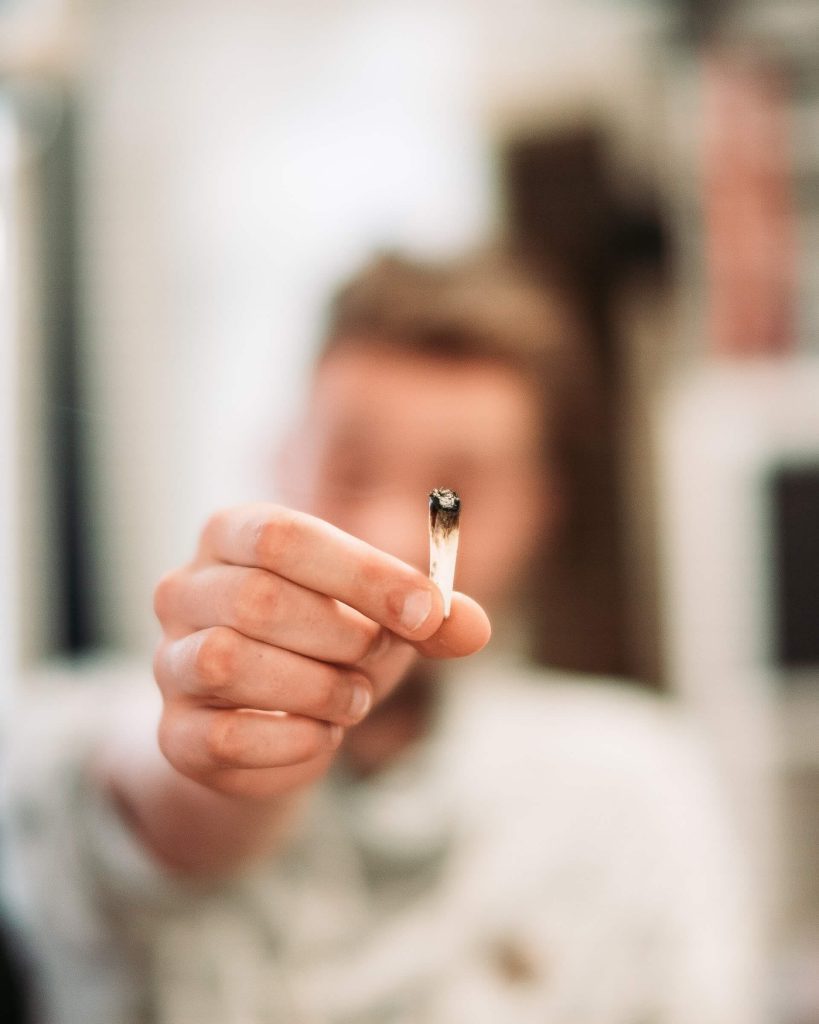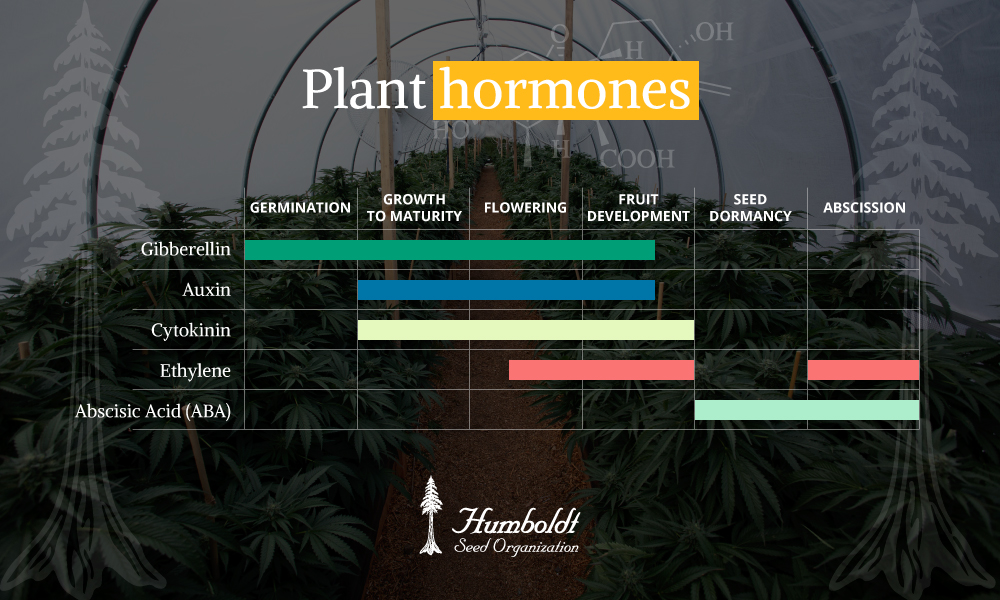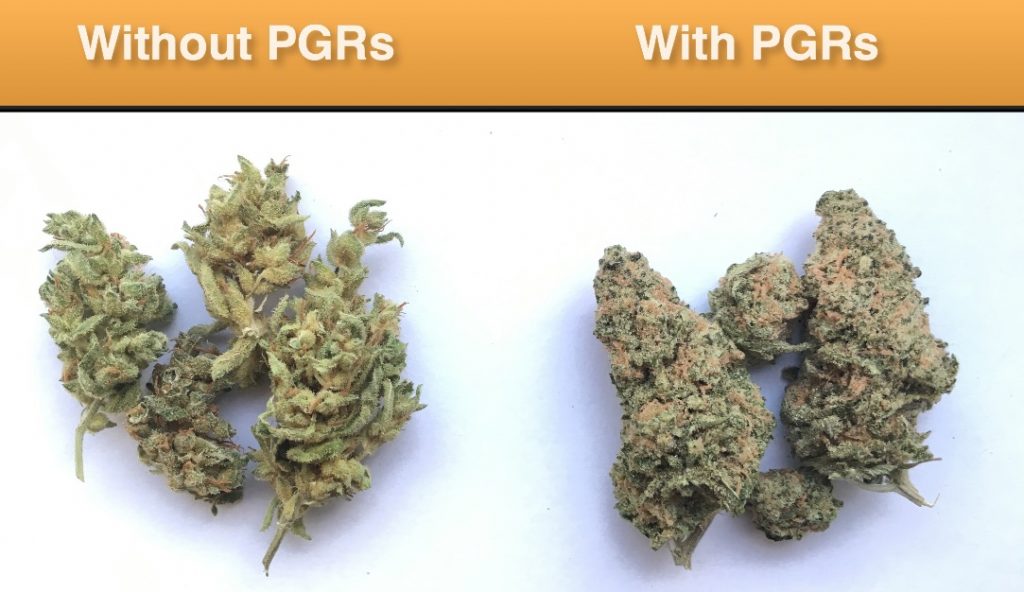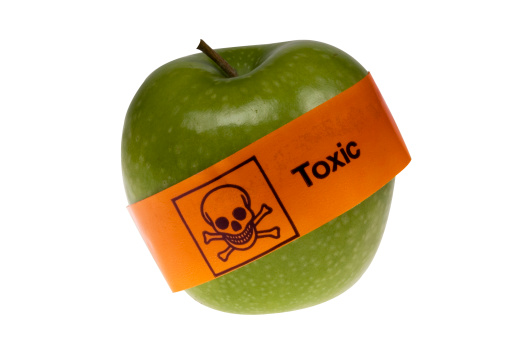
What are PGRs and are they bad for me? | PGRs Weed
Share This Article
Article Summary
In recent months, the conversation around Plant Growth Regulators (PGRs) in cannabis cultivation has resurfaced, sparking a blend of curiosity and concern among consumers and cultivators alike. With the global PGR market projected to grow significantly, it’s crucial to understand what PGRs are, their implications for cannabis quality, health effects, and the environment.
What Are PGRs?
PGRs are substances that influence the growth and development of plants. They can be synthetic, mimicking natural plant hormones to alter growth patterns and yields, or organic, derived from natural sources. Synthetic PGRs, such as Paclobutrazol, Daminozide (Alar), and Chlormequat Chloride, are known for their efficiency in boosting plant size and yield but come with significant health and environmental risks. In contrast, organic PGRs like Chitosan and Triacontanol offer a safer, more sustainable approach to enhancing plant growth without the adverse effects associated with their synthetic counterparts????.
Implications for Cannabis Cultivation
Cannabis cultivators use PGRs for various reasons, including controlling plant size, increasing flower density, and improving yield. However, this comes at a cost. Cannabis grown with synthetic PGRs may have artificially dense buds, but these can be lacking in cannabinoid and terpene profiles, essential for the plant’s therapeutic and sensory qualities. Moreover, there’s evidence to suggest that the combustion of PGR-treated cannabis could release harmful compounds, posing health risks to consumers????.
Health and Environmental Concerns
The health implications of consuming PGR-treated cannabis are worrying. Studies have linked synthetic PGRs to various health issues, including cancer, liver damage, and reproductive problems. Environmental impacts are equally concerning, with PGRs contributing to soil and water pollution, affecting biodiversity and potentially harming non-target species such as fish????.
The Case for Natural Cannabis Cultivation
Given the potential risks associated with PGRs, a shift towards natural cannabis cultivation methods is gaining momentum. By eschewing PGRs, cultivators can produce cannabis that not only respects the plant’s natural growth cycle but also ensures a safer product for consumers. This approach aligns with increasing consumer preference for organically grown cannabis, highlighting a collective move towards health-conscious and environmentally sustainable practices??.
In conclusion, while the allure of higher yields and robust growth may tempt some to use synthetic PGRs in cannabis cultivation, the health and environmental risks they pose cannot be ignored. Organic PGRs present a safer alternative, but the best practice remains cultivating cannabis in its natural state. As the cannabis industry continues to evolve, prioritizing safety, sustainability, and transparency will be key to building trust and ensuring the well-being of consumers and the environment.
We’ve been hearing a lot more about PGRs Weed again in recent months. But what actually are PGRs? Are they all bad? And what do PGRs Weed growers actually use?
This week, we’ll explore the relationship between PGRs and Cannabis cultivation.
In this piece, we won’t give you a science lecture. Instead, we’ll try to avoid the jargon and technicalities, focusing on why growers may use these chemicals and how they can affect the human body when consumed.
What is PGRs Weed?
The FIFRA defines plant growth regulators as “Any substance or mixture of substances intended, through physiological action, for accelerating or retarding the rate of growth or rate of maturation, or for otherwise altering the behaviour of plants or the produce thereof.”
Plant growth regulators, also sometimes referred to as Plant Growth retardants, are a group of chemicals used in agricultural farming on crops such as grape and tomato vines, peppers and aubergines to increase their yield, decrease the frequency of fruit drop and manipulate fruit development and storage quality.
Although plant growth regulators have been used in traditional agricultural cultivation of edible crops for decades following their discovery in the late 1920s with seemingly little harm attributed to their use, it remains unknown as to the long-term health effects of pgrs weed, especially when combusted and consumed orally.
It is suspected that when cannabis grown with PGRs is combusted, the trace amounts of these chemicals become volatile; through heat, they break down and become a gas which is inhaled along with the cannabis smoke, potentially becoming toxic and harmful to consumers.
(This is why you see farmers in hazmat suits spraying these chemicals onto crops.)
The potential for inhalation and dermal contact are of concern here, given the concentrated nature of the compound before it israyed.
However, when ingested in trace amounts, such as in foods produced from sprayed crops, these chemicals break in the gut and appear to have little detrimental effect on the consumer.
PGRs Weed and The Environment
Growing evidence suggests that as well as posing a potential threat to human health, PGRs are environmental pollutants. Residual PGRs in the soil and water are shown to have toxic effects on the digestive organs of fish and their embryos. I would suggest that far more research needs to be done to end this protracted debate once and for all.
PGRs in food production aren’t even guaranteed 100% safe, as the research and data are seriously lacking to demonstrate beyond any doubt the efficacy and safety of PGRs in food production.
We need more studies examining the retention of residues in the leaves and fruit of vegetable crops. This should interest regulators and cultivators alike, especially considering customers are consuming fresh vegetables treated with PGRs.
So why, then, are some growers still using PGRs in the cultivation of Cannabis?
There are three main reasons why:
1. To stop vertical growth and get a head start on flower production during the transition from vegetation to flower stage in cultivation during the first two weeks of flowering.
2. To boost the density and yield of flowers during the mid-phase of flowering weeks three to five.
3. PGRs weed may be grown to harden the flowers during the final stage of flowering, the final two weeks of growth.
Effectively, there is only one main driving force behind their adoption of these untested methods, and that is profit.
It is interesting to note that the global PGR market is expected to surge from $3.5 billion observed in 2014 to $6.4 billion by 2020 (source), possibly on the back of increased usage in the cultivation of cannabis.
PGRs seem far more ubiquitous in the States than in the UK. However, they’re slowly entering the UK market as “Cali” strains and other imports become more popular.
So be aware that the cannabis you’re consuming may have been grown using these untested and unregulated products.
As always, the safest way to access cannabis is to cultivate it yourself. Then, you’ll know what has been added to the crop and how the plant has been treated.
As mentioned above, it’s not just PGRs that are being utilised in the cultivation process; there are also Fungicides, Herbicides and Insecticides, all used in domestic food agriculture with little to no detrimental effects on the consumer.
So, although these chemicals can be toxic in high doses and require PPE (Personal Protective Equipment) to spray, they seem relatively harmless in small doses, such as the amount ingested when eating crops that utilise these or similar chemical compounds in their production. However, in recent years, there has been growing evidence showing that PGRs are carcinogenic, toxic to the liver and may cause infertility.
Most PGRs are banned or classified and regulated as pesticides in Europe and the UK. However, rather worryingly for us and despite being prohibited in many countries, Paclobutrazol is still licensed for use on apple, cherry, pear and plum trees in the UK.
So remember that your PGR joint and local supermarket apples may be potentially harmful.
The science is complicated, and everyone has their own opinion about PGRs, their efficacy and the effects of using them in agricultural production, let alone Cannabis cultivation.
That being said, I’d say it’s far better to air on the side of caution and avoid using these chemicals in cannabis cultivation until there is a great deal more relevant and reliable information available about any potential health risks arising from using PGRs in cannabis products.

On the other hand, it could be argued that if you’re not overly concerned about your physical health anyway, consuming some pgrs weed is only as bad as eating takeaway junk food – however, do bear in mind that British takeaway food is linked to obesity, heart attack, Stroke, diabetes and early death. (Source)
Ultimately, there is not enough evidence either way on the efficacy of plant growth regulators in cannabis cultivation.
Until there is sufficient evidence, either way, I’d recommend avoiding these compounds and Cannabis cultivated using them.
Simpa
DCCC
Understanding Plant Growth Regulators in Cannabis Cultivation
Cannabis cultivation has evolved significantly, incorporating various techniques and products to enhance growth and yield. Plant Growth Regulators (PGRs) have become a notable component among these. Plant growth regulators are substances that influence the plant’s growth and development. However, not all PGRs are created equal. There’s a distinct difference between synthetic and organic plant growth regulators, each with unique implications for the plant, consumer, and environment.
Synthetic PGRs: High Efficiency, High Risk
Synthetic PGRs are chemically formulated to mimic natural growth substances. They are widely used because they enhance plant size and yield. However, the risks associated with synthetic PGRs are significant, both to human health and the environment.
- Paclobutrazol: This synthetic PGR is known for its ability to create densely packed cannabis buds by rapidly dividing the plant cells. While this increases the yield, it negatively impacts the plant’s natural cannabinoid and terpene profiles. Health-wise, Paclobutrazol is linked to adverse effects on male reproductive health and liver function. It may also turn carcinogenic when heated.
- Daminozide (Alar): Commonly used in the growth of tree fruits, Daminozide finds its way into cannabis cultivation to improve bud structure. However, its use is controversial. The US EPA has banned its use in food crops due to its classification as a probable human carcinogen.
- Chlormequat Chloride: This PGR effectively increases yield but poses health risks. Short-term exposure can lead to lung irritation and nausea, while long-term exposure may cause liver damage. Though it’s still permitted in non-food crops, its safety for human exposure remains a concern.
Organic PGRs: A Safer Alternative
Organic PGRs, instead of their synthetic counterparts, are derived from natural sources and considered safer for both the plant and consumers.
- Chitosan: This natural compound is deemed safe for cannabis cultivation. It doesn’t carry the risks associated with synthetic PGRs, making it an environmentally friendly and health-conscious choice.
- Triacontanol: Another organic option, Triacontanol, is effective in stimulating plant growth without the adverse effects of synthetic PGRs. It’s a preferred choice for cultivators looking for safe and sustainable cultivation practices.
The Balance Between Yield and Safety with PGRs weed
While synthetic plant growth regulators offer the allure of higher yields and robust growth, the potential health risks and environmental impacts cannot be overlooked. Organic plant growth regulators, though sometimes more costly, provide a safer, more sustainable approach to cannabis cultivation. They ensure that the plants grow healthily without compromising the safety of consumers and the environment.
Should I avoid PGRs weed?
When considering whether to avoid plant growth regulators-enhanced weed, weighing the health and environmental risks associated with synthetic PGRs is important. These chemicals, like Paclobutrazol and Daminozide, can lead to potential health hazards, including carcinogenic risks and disrupt the natural cannabinoid profile of cannabis. Organic PGRs offer a safer alternative but still alter the plant’s natural state. Embracing cannabis grown naturally, without any plant growth regulators, ensures a purer and potentially safer product, aligning with eco-friendly practices and consumer preferences for organically grown substances. Ultimately, choosing PGR-free weed is a healthier and more environmentally conscious decision.
Stop PGRs Weed – The Natural Way is Better
Moving beyond the debate between synthetic and organic PGRs, there’s a growing trend among cannabis cultivators to embrace natural cultivation methods, completely avoiding the use of PGRs. This approach champions the belief that the most holistic and healthiest way to grow cannabis is by allowing it to flourish in its natural state, supported by traditional agricultural practices.
Embracing the Plant’s Natural Growth Cycle
Cannabis, like any other plant, has its unique growth cycle and characteristics. Cultivators not using PGRs allow the plant to follow its natural growth pattern. This approach might result in lower yields compared to PGR-enhanced cultivation, but it ensures the development of cannabinoids and terpenes as nature intended. The natural growth process typically results in a more complex and richer profile of these compounds, leading to a superior quality product.
Health and Safety Considerations
One of the most compelling reasons to avoid Plant Growth Regulators in cannabis cultivation is health and safety. Synthetic PGRs, as discussed, come with potential health risks. Even organic PGRs, though safer, can alter the plant’s natural state. By growing cannabis naturally, cultivators can provide consumers with a product free from any chemical interference, ensuring a pure and safe experience.
Environmental Sustainability
Natural cultivation methods are inherently more sustainable. They do not rely on chemically synthesised products, thereby reducing the environmental footprint of cannabis cultivation. This approach aligns with broader environmental goals and appeals to an increasingly eco-conscious consumer base. Sustainable cultivation practices also contribute to soil health and biodiversity, ensuring the longevity of agricultural land.
Market Trends and Consumer Preferences
The market for naturally grown cannabis is on the rise. Consumers are becoming more health-conscious and environmentally aware, leading to a preference for organically grown products. Cannabis cultivated without plant growth regulators is often perceived as a premium product, reflecting a commitment to quality and sustainability. This shift in consumer preference is shaping the industry, encouraging more cultivators to adopt natural growing methods.
The trend towards natural cultivation methods in the cannabis industry is a response to health, safety, and environmental concerns. It reflects a growing understanding that the best way to produce high-quality cannabis is not through artificial enhancement but by respecting and nurturing the plant’s natural lifecycle. As the industry evolves, the move towards natural cultivation practices may not only become a preference but a standard, shaping the future of cannabis production for the better.
The choice between synthetic and organic plant growth regulators in cannabis cultivation is more than just a matter of yield. It’s about considering the long-term health implications and environmental impacts. As the cannabis industry continues to grow, it’s crucial to prioritise safe and sustainable cultivation practices. By choosing organic PGRs, cultivators can contribute to a healthier, more environmentally friendly future for cannabis production. PGRs weed contains may be synthetic, and should be avoided if possible. While it is possible to use PGRs weed may benefit from without as many risks by using natural PGRs, weed grown fully naturally will have the lowest consumption risks.
There are potential health risks associated with human ingestion and inhalation of PGRs. We’ll be expanding on this subject and hopefully providing as much information as possible to help UK cultivators decide for themselves whether it is worth risking their long-term health for short-term financial gains, as well as asking whether it is right to add PGR’s to Cannabis and selling it without informing the consumer potentially damaging their health.
Once again, the definition of a PGR is: “Any substance or mixture of substances intended, through physiological action, for accelerating or retarding the rate of growth or rate of maturation, or for otherwise altering the behaviour of plants or the produce thereof.”
They are synthetic chemicals specifically designed to moderate plant behaviour, and many are potentially extremely toxic. Most of Europe and the UK currently have either banned them or strictly regulates them, classifying them as pesticides, herbicides or fungicides.
One of these PGR’s masquerading as a fungicide and is available in large parts of Europe is Paclobutrazol (PBZ) which is currently being used in Britain in the cultivation of many Perennials like apples and pears.
Paclobutrazol inhibits the natural plant hormone Gibberellins, which is responsible for cell elongation and cell division. This, in turn, limits the height of the plant and internodal length.
As a result, fruits and flowers come out more compact and dense, a highly desired trait with certain plant species such as Cannabis, and they also initiate earlier flowering, another desirable trait.
Its use is prohibited in many countries as the World Health Organisation (WHO) lists Paclobutrazol as “Moderately Hazardous” and the US Environmental protection agency (EPA) lists it as “not classifiable as to human carcinogenicity” however this may be due to the absence of such tests, given the fact it isn’t used on consumable crops, so isn’t subject to such mandatory tests.
It is important to note that there are no known studies looking at the effects of the volatilisation of Paclobutrazol and the effects of human inhalation. Even the US, who have a rather questionable history with chemical additives in their food chain won’t allow Paclobutrazol to be a part of it.
In fact, it is only licensed for use on outdoor ornamentals, greenhouse ornamentals and general turf.
What about natural PGR’s?
In order to answer this question, we must first understand what plant hormones are and how they function within the plant. Plant hormones called Phytohormones are naturally concurring and are similar to animal hormones. They play a fundamental role in the growth, development and regulation of the plant throughout its life cycle.
The smallest amount of these naturally occurring endogenous chemicals allows the plant to turn on or off certain genes and regulates the expression of certain characteristics, making some appear more prominent than others and allowing the plant to adapt to its environment.
Considering they’re such a relatively simple molecular structures they have huge and diverse effects on the plant development and growth cycle. Natural regulation of these plant hormones comes through environmental cues and receptors as well as the plant’s genome.
It is traditionally accepted that there are five major classes of endogenous naturally occurring plant hormones that play key roles in a plants life cycle.
Plant Hormones
Each of these has their own regulatory functions and roles in the plant’s natural growth cycle. They can either inhibit or increase cell growth and activity. They most often work in synergy with one another in varying ratios throughout a plants life.

The above table shows the natural growth cycle a plant will go through and how it utilises the five major classes of phytohormones.
There has also been since the original discovery of these five major classes additional types of phytohormones such as Brassinosteroids, which have also been found to regulate a wide range of physiological processes including plant growth, development and immunity.
Again, far too little is known about plant hormones models when compared to mammalian hormones, so it is possible that there are many more to be discovered, and there is likely much more to be learned about the effects of hormone manipulation in plants in this way.
Synthetic PGR’s are chemical additives created to mimic and emulate these naturally occurring Photohormones and the processes they stimulate and regulate.
Given the known dangers of these products, they are strictly only used under license by the USDA (United States Department of agriculture) on ornamental crops and other crops not destined for human consumption. However, because of the current federal legal status of cannabis, neither the USDA, FDA or any other regulatory agency or public authority is inclined to either regulate or to provide information about the detrimental effects of these substances on individual health.
Given the immense legal grey area created by prohibition the producers of cannabis specific plant feeds, nutrients and chemical additives are less stringently regulated than edible and ornamental crops despite there potentially being a bigger exposure risk due to the volatility of the chemicals when combusted in consumption.
This allows and arguably incentivises unscrupulous growers to use and abuse these substances. Most of which have been banned from the majority of western countries for use on consumable crops.
So if you want to reduce any potential harm from any unlisted ingredients and additives in cannabis specific feeds then cannabis needs to be legalised so that quality control and regulations ensure that the cannabis that is produced for consumption by the public is of the highest quality and free of chemical and minerals that are not suitable for human consumption. This would also force the regulation of these chemicals and their producers.
There is also the “Cocktail effect” to take into consideration which could also further compound the potential harms created by these substances. We didn’t find any research on the cocktail effect specifically focusing on volatility e.g. burning and breathing into the lungs.
To be frank, sometimes it seems to be the market itself that is pushing the demand for PGR’d cannabis. By demanding denser, harder “nugs” the average consumer is unfittingly motivating growers to use potentially dangerous chemicals, untested and unsafe additives in the cultivation of their cannabis, but what good is wealth without health?
The profit motive is – as it has always been – the primary motivator behind the rise in PGR’d cannabis in the UK, along with a desire for that “Cali” looking bud and exclusive strains. (Most of which has failed pesticide and mould tests anyway. Why do you think those tins end up here?)
Post-prohibition any substance that has or is potentially harmful to human health will be banned or at the very least clearly labelled with a warning and be strictly regulated in the same way as any other potentially dangerous legal product.
Ultimately not enough is known about the long-term effects of PGR’s on plants, let alone humans, and with no research being conducted into the dangers around volatilising and inhaling these compounds it is advisable to give Cannabis grown with PGR’s a miss.
Using potentially dangerous chemicals just to make money while harming your fellow man is low.
Simpa
DCCC
Further Reading
- https://www.mountainjackpot.com/2015/03/03/beware-of-pgrs-and-toxic-pesticides-commonly-used-on-marijuana-lono/
- https://medicalmarijuana.com.au/growing/growing-cannabis/what-are-pgr-s-and-why-are-they-in-my-weed
- https://manicbotanix.com/pgrs-and-medical-marijuana/
- https://marijuanagrowershq.com/plant-growth-regulators-poison-marijuana/




